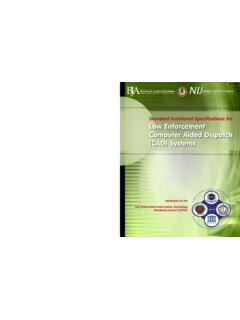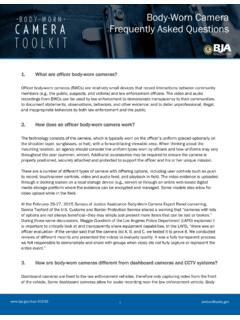Transcription of building an offender reentry program - Bureau of Justice ...
1 building an offender reentry program : a guide for law enforcementacknowledgmentsThis project was supported by grant number 2005-MU-MU-K012 awarded by the Department of Justice , Office of Justice Programs Bureau of Justice Assistance. The opinions, findings, and conclusions or recommendations expressed in this docu-ment are those of the authors, and do not necessarily represent the official position or policies of the Department of Justice . The International Association of Chiefs of Police (IACP) is grateful to a number of individuals who were instrumental in developing this guide. The IACP was fortunate to receive valuable input from approximately 50 law enforcement officials from 21 states and Canada who contributed information on their offender reentry program experiences through their participation in our regional focus groups and site visits. Specifically, we offer our appreciation to: n Chief David Spenner (retired) and Sergeant Steve Madsen of the Racine (WI) Police Department for lending their experience in a variety of ways to include the production of the video, offender reentry : A Police Perspective.
2 N Those agencies represented at each of the regional focus groups and the sites profiled in this guide. n Jim Jordan, Chief Alberto Melis, and Lieutenant Blake Miller for their review and contributions to this more information about law enforcement s role in offender reentry efforts or information contained in this guide, please contact offender reentry Project Manager Stevyn Fogg at the IACP: 1-800-THE-IACP ext. 842 or OF CONTENTSINTRODUCTIONSECTION I: offender reentry 101 What is offender reentry ? ..2 What is Law Enforcement s Role in offender reentry ? .. 2 Why would Law Enforcement Participate in offender reentry ? ..3 What are the Benefits to Law Enforcement Participation in offender reentry ? ..3 What are the Challenges to Law Enforcement Participation in offender reentry ? .. 4 What should Law Enforcement Know Before Participating in offender reentry ? ..5 SECTION II: building AN offender reentry PROGRAMN eeds Assessment.
3 8 Components and Activities ..9 Funding and Resources ..11 Practical Tools and Instruments ..12 building Partnerships ..13 Management and Operations ..15 Measuring Success ..19 Key Recommendations and Advice ..21 SECTION III: CURRENT STATE OF PRACTICE EXAMPLES FROM LAW ENFORCEMENTC ampbell County Police Department (KY) ..25 Indianapolis Police Department/Marion County Sheriff s Department (IN) ..27 Las Vegas Metropolitan Police Department (NV) ..29 Louisville Metro Police Department (KY) ..31 Lowell Police Department (MA) ..33 Minneapolis Police Department (MN) ..35 New Haven Department of Police Service (CT) ..37 Park City Police Department (UT) ..39 Racine Police Department (WI) ..41 Redmond Police Department (WA) ..43 Savannah Chatham Metropolitan Police Department (GA) ..45 Topeka Police Department (KS) ..47 High Point Police Department/Winston-Salem Police Department (NC).
4 49 GLOSSARY .. 51 RESOURCES AND MATERIALS .. 51 According to the U .S . Department of Justice (DOJ), Office of Justice Programs (OJP), on an annual basis, more than 650,000 offenders are released from incarceration and return to com-munities nationwide .1 Research from OJP s Bureau of Justice Statistics (BJS) indicates that two-thirds of those released are likely to recidivate . Given this, offenders who are released pose a significant challenge to public safety .In response to the growing number of returning offenders, DOJ launched a reentry initiative that supported the creation of programs at various levels in all 50 states, the District of Columbia, and the U .S . territories . Additionally, federal, state, local, and private agencies and organizations have partnered to study and develop best approaches to offender reentry . The consensus is that offender reintegration requires a concerted effort among criminal Justice practitioners to address the impact made by returning offenders.
5 As a result, many programs have been implemented to transition released offenders back into the community and reduce recidivism .In the 1990s, an increasing number of returning offenders spurred innovation within local law enforcement and among other stakeholders . Intensive supervision partnerships between law enforcement and community corrections, like Boston s Operation Night Light, have been chronicled and championed . While law enforcement and corrections partnerships showed promise, the offender reentry concept was envisioned as a more comprehensive approach . This broadened concept called for support, beyond enforcement, to include provision of needed services such as education , housing, substance abuse treatment, and employment . This reentry concept embodies the figurative carrot (services) and stick (enforcement) approach . While reentry literature is robust, very little of it addresses the role that law enforcement has or should have.
6 Moreover, reentry programs have flourished while strategic involvement of police has not .In an effort to determine the state of law enforcement s participation in offender reentry initia-tives, the International Association of Chiefs of Police (IACP) partnered with OJP s Bureau of Justice Assistance (BJA) to comprehensively examine law enforcement s role in offender reentry initiatives . IACP s goal, through this project, is to increase law enforcement s participa-tion in offender reentry through the provision of information, sharing of leading practices, and development of products to promote public safety partnerships . The intended outcomes of this effort--through increased law enforcement participation in reentry programs--are reduced recidivism , victimization, and disorder while increasing officer safety .INTRODUCTIONDue to the limited information available on law enforcement participation in reentry efforts, IACP qualitatively and quanti-tatively examined the potential for intensified law enforcement involvement in three ways:1.
7 Literature Review. We conducted a review of the literature to determine the mission and critical elements of reentry as it relates to law enforcement . Next, we developed a list of questions arising from a review of research reports and policy statements on reentry and relevant programs . The questions focused on identifying policy and operational gaps within law enforcement as it relates to reentry .2 . Focus Groups. In an effort to identify leading practices in law enforcement s participation in offender reentry initiatives, IACP staff conducted a series of focus groups . Approximately 50 law enforcement officials from 21 states and Canada participated in five regional focus groups .3 . Site Visits. IACP staff conducted site visits to more than 15 police and sheriffs departments . The site visits were designed to document how law enforcement is engaged and to examine the operational aspects of its reentry efforts.
8 Profiles of some of the programs exhibiting potentially rep-licable and leading practices are located later in this guide .The information gathered through our efforts provided mate-rial for the IACP to develop a guide for law enforcement by law enforcement . The purpose of this guide is to:n Provide an overview of the information available specifically on law enforcement s current and emerging role in offender reentry .n Present key strategies, components, and results of law enforcement participation in offender reentry programs .To illustrate, this resource guide is presented in sections:n Section I: offender reentry 101 provides an overview of the questions and responses law enforcement has and may have about its role in offender reentry ; identifies the benefits and challenges that police experience with reentry programs; and provides examples of how law enforcement agencies have developed, implemented, and managed such programs.
9 N Section II: building an offender reentry program provides a blueprint for law enforcement interested in implementing an offender reentry program . This section presents real-life examples from the sites visited that exhibit leading practices in law enforcement-involved offender reentry programs . n Section III: Current State of Practice: Examples from Law Enforcement highlights law enforcement agencies that are engaged in offender reentry programs and initiatives .n The Glossary provides definitions of commonly used offender reentry terms .n The Resources and Materials section contains a list of helpful online resources used by offender reentry project staff and profiled agencies . reentry programs use a variety of terms to describe offenders who are participating in offender reentry programs . For the purposes of this guide, the term offender is used to describe ex-offenders, ex-convicts, former inmates, felons, formerly incarcerated individuals, probationers and parolees, and program participants or candidates in the programs profiled.
10 SECTION I: offender reentry 101 S E C T I O N I : O F F E N D E R R E E N T R Y 1 0 1 WhAT IS O FFENDER R EENTRY? offender reentry , which is also known as reentry , prisoner reentry , or re-entry, refers to the return of offenders from incarceration back into the community . In general and for the purposes of this guide, reentry refers to persons released from state or federal prisons, individuals discharged from parole, and those under probation . As a concept, reentry involves any program , initiative, or partnership that addresses the issues necessary to ensure that offenders successfully transition and maintain a crime-free existence post-release . These issues commonly include lack of education , job training or vocational experience, housing, and/or substance abuse and mental health treatment . From a law enforcement perspective, offender reentry :n Is an issue of officer and community safety.













